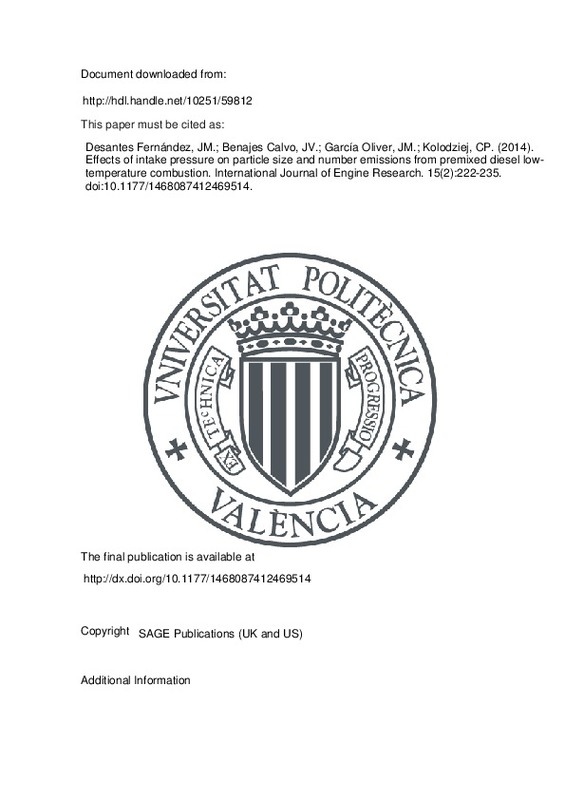JavaScript is disabled for your browser. Some features of this site may not work without it.
Buscar en RiuNet
Listar
Mi cuenta
Estadísticas
Ayuda RiuNet
Admin. UPV
Effects of intake pressure on particle size and number emissions from premixed diesel low-temperature combustion
Mostrar el registro sencillo del ítem
Ficheros en el ítem
| dc.contributor.author | Desantes Fernández, José Mª
|
es_ES |
| dc.contributor.author | Benajes Calvo, Jesus Vicente
|
es_ES |
| dc.contributor.author | García Oliver, José María
|
es_ES |
| dc.contributor.author | KOLODZIEJ, CHRISTOPHER PAUL
|
es_ES |
| dc.date.accessioned | 2016-01-13T12:09:41Z | |
| dc.date.available | 2016-01-13T12:09:41Z | |
| dc.date.issued | 2014-02 | |
| dc.identifier.issn | 1468-0874 | |
| dc.identifier.uri | http://hdl.handle.net/10251/59812 | |
| dc.description.abstract | In this study, 10 premixed diesel low-temperature combustion engine operating conditions were chosen based on engine intake pressure (1.2-1.6 bar), intake oxygen concentration (10%, 11%, and 12%), and injection timing (-24 degrees after top dead centre in all test conditions). At each intake oxygen concentration, the effects of intake pressure on combustion parameters and emission measurements (carbon monoxide, hydrocarbons, nitrogen oxides, particulate matter mass concentration, and particle size distributions) were analyzed. Although increased intake pressure resulted in higher in-cylinder charge air density that improved fuel/air premixing and late-cycle oxidation quality, higher intake pressure also advanced the start of combustion and thereby decreased the time available for fuel and air premixing. But even with the decrease in premixing time available before start of combustion, increased intake pressure caused significant decreases in carbon monoxide, hydrocarbon, particulate matter mass, and particle number emissions. Particle size distribution measurements allowed greater understanding of how higher intake pressure decreased the particulate matter mass concentrations with respect to particle size. To further investigate the experimental results, a zero-dimensional engine heat release code was used to analyze combustion temperatures, and a one-dimensional free spray model was used to estimate the relative levels of liquid fuel spray impingement on the piston surface and maximum local equivalence ratio at start of combustion for each test case. Therefore, though the premixing time was shortened by higher intake pressures, the decreased emissions were understood by combined effects of enhanced fuel and air premixing quality and improved late-cycle oxidation near the end of combustion. | es_ES |
| dc.description.sponsorship | This research has been carried out in the frame of the project PROMETEO/2010/032 supported by the Generalitat Valenciana. Financial support for Christopher P. Kolodziej was provided by the Spanish Ministry of Education (Formacion del Profesorado Universitario). | en_EN |
| dc.language | Inglés | es_ES |
| dc.publisher | SAGE Publications (UK and US) | es_ES |
| dc.relation.ispartof | International Journal of Engine Research | es_ES |
| dc.rights | Reserva de todos los derechos | es_ES |
| dc.subject | Diesel | es_ES |
| dc.subject | Premixed | es_ES |
| dc.subject | Low-temperature combustion | es_ES |
| dc.subject | Particle emissions | es_ES |
| dc.subject | Intake pressure | es_ES |
| dc.subject.classification | MAQUINAS Y MOTORES TERMICOS | es_ES |
| dc.title | Effects of intake pressure on particle size and number emissions from premixed diesel low-temperature combustion | es_ES |
| dc.type | Artículo | es_ES |
| dc.identifier.doi | 10.1177/1468087412469514 | |
| dc.relation.projectID | info:eu-repo/grantAgreement/GVA//PROMETEO%2F2010%2F032/ | es_ES |
| dc.rights.accessRights | Abierto | es_ES |
| dc.contributor.affiliation | Universitat Politècnica de València. Departamento de Máquinas y Motores Térmicos - Departament de Màquines i Motors Tèrmics | es_ES |
| dc.description.bibliographicCitation | Desantes Fernández, JM.; Benajes Calvo, JV.; García Oliver, JM.; Kolodziej, CP. (2014). Effects of intake pressure on particle size and number emissions from premixed diesel low-temperature combustion. International Journal of Engine Research. 15(2):222-235. https://doi.org/10.1177/1468087412469514 | es_ES |
| dc.description.accrualMethod | S | es_ES |
| dc.relation.publisherversion | http://dx.doi.org/10.1177/1468087412469514 | es_ES |
| dc.description.upvformatpinicio | 222 | es_ES |
| dc.description.upvformatpfin | 235 | es_ES |
| dc.type.version | info:eu-repo/semantics/publishedVersion | es_ES |
| dc.description.volume | 15 | es_ES |
| dc.description.issue | 2 | es_ES |
| dc.relation.senia | 265493 | es_ES |
| dc.contributor.funder | Generalitat Valenciana | es_ES |
| dc.contributor.funder | Ministerio de Educación | es_ES |







![[Cerrado]](/themes/UPV/images/candado.png)

